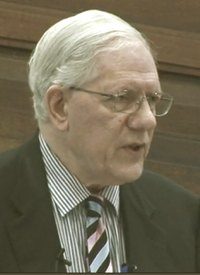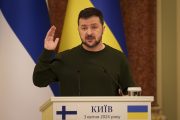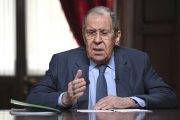
This is Part One of an interview by William F. Jasper, Senior Editor of THE NEW AMERICAN, with Christopher Story (left), editor of the London-based Soviet Analyst, an intelligence commentary, and editor of The Perestroika Deception by Anatoliy Golitsyn, the Soviet defector and famous author of New Lies for Old. The interview was conducted on August 16 1995 in the Presidio, San Francisco, outside the headquarters of the Gorbachev Foundation/USA. Part Two, Leninists Still Leading, and Part Three, Red March to Global Tyranny, are also available online, along with additional articles related to Anatoliy Golitsyn and Communist deception and convergence that we have linked to at the end of this article.
Q. Why did you start publishing Soviet Analyst, and how does that publication differ from other sources concerned with Soviet Russia, Communism, etc ?
A. Soviet Analyst had been published since 1972 by a group of people in London with long-established connections with the British Foreign Office. Around midsummer 1991, they approached me, knowing that I might be interested in buying the paper, and revealed that they wanted to sell it. Their reasoning was that “it was all over”; the Soviet Union was finished. Interestingly, they thought this well before the “August coup,” which took place on August 19, 1991.
Since these people had Foreign Office connections, they had essentially reflected the Foreign Office line. At the time, the Foreign Office was busily recognizing the alleged political “independence” of the Soviet Republics, one by one, and generally appeared to be doing everything possible to reinforce the illusions of “change” which were being staged by the Soviet strategists in pursuit of their objectives. We have inherited old issues of Soviet Analyst going back to 1972, from which it is very clear that Soviet Analyst was an “arm’ s length” vehicle for Foreign Office opinion about the Soviet Union. In acquiring this title, I saw an opportunity to counter disinformation about Soviet developments. We started publishing Soviet Analyst in November 1991, stressing the Soviets’ Leninist use of strategic deception, and explaining it to our readers. We started from the assumption that there had been no true discontinuity. Hence Soviet Analyst differs from probably all other publications in that our analysis shows that the apparent “Break with the Past” is a deception, and that “perestroika” and post-“perestroika” represent further stages of the Leninist World Revolution.
Q. From Oxford to Stanford to the Rand Corporation to London, Paris and Berlin, there are hordes of Sovietologists and Soviet defectors who are busily informing the West about what is “really happening” in the so-called ‘”former” Soviet Union. You have singled out the work of the Soviet defector Anatoliy Golitsyn. Why do you think he is unique ?
A. Golitsyn is probably the most important Soviet defector ever to have reached the West. The reason for this is that he revealed the details of a long-range deception strategy of which the West previously had no knowledge. When debriefed, he emphasized, as he has done ever since, that because of his background of working within the “inner KGB” — a super-secret strategic planning department of which not even ordinary KGB officers were aware — he was uniquely qualified to inform the West about Soviet strategy. One of the superficial criticisms frequently made about Golitsyn is that he has been “out of the loop” since defecting to Finland with his wife and daughter in 1961, so how could he possibly know what was going on? People who say this reveal a failure to understand Golitsyn’s significance, and what he has to offer the West.
In summary, Golitsyn’s importance is that, unlike all other defectors, Golitsyn discusses and elaborates upon Soviet strategy. By contrast, defectors like Oleg Gordievsky discuss mundane matters concerning the manner of their “escape” from the Soviet Union, perhaps revealing valuable operational information in order to gain the confidence of (in Gordievsky’s case) Britain’s MI6, before inserting strategic disinformation in their output. Golitsyn is different. He has spent his years in the West explaining patiently that the Soviets follow Leninist strategic principles, and are engaged in a deadly long-term war against the West. The Soviet revolutionaries have followed Lenin’s advice to “work by other means.”
Q. If we examine Golitsyn’s record since 1961, do we have reason to place faith in his analysis and his analytical methods ?
A. At a superficial but easily explained level, Golitsyn’s public fame derives from the fact that in 1980, he completed a work called New Lies for Old, which was in fact published in 1984. This book contained explicit predictions concerning the future course of Soviet strategy, which events subsequently proved to have been correct. In his recent book, published in 1994, entitled Wedge: The Secret War between the FBI and CIA, Mark Riebling explained that after carrying out a careful analysis of Golitsyn’s predictions in New Lies for Old, he had found that out of a total of 148 falsifiable predictions, 139 had been verified by 1993 — “an accuracy rating of 94%.” This achievement places Golitsyn in a league of his own, putting most other observers to shame.
Q. And the predictions he made concerned very significant, “earth-shattering” developments…
A. Golitsyn’s main predictions included details of the forthcoming false liberalization of the whole of Eastern Europe, followed by similar developments in the Soviet Union. He predicted the removal of the Berlin Wall, the unification of Germany, the restructuring (if not abolition) of NATO. He even went so far as to specify that a “Break with the Past” process would start in East Germany, with the opening of its borders — as it turned out, to neighboring Communist countries. That was quite remarkable: Golitsyn knew that the process would start in East Germany; and it did.
Q. For 34 years, Golitsyn has remained in hiding. He has never been seen in public; his whereabouts are a closely guarded secret. Meanwhile, other defectors are conducting national tours, appearing on television, or writing in the press. I recently saw Yuri Svets on C-Span, hawking his new book dealing with his KGB activities while stationed in Washington. Is Golitsyn’s secrecy a reflection of his prudence, or of paranoia?
A. Well, those who seek to discredit him routinely accuse him of paranoia. That is, of course, a mistake. Golitsyn was condemned to death in 1962, after Semichastniy, then head of the KGB, had formally asked the Party for its approval that he should be liquidated. A Soviet defector who I am advised is reliable, reported to me that he had seen a book on display in the Lubyanka [KGB headquarters] in Moscow, listing the names and details of Traitors to the Motherland, complete with photographs. Golitsyn features in this book, which states that those listed are to be reported or killed. Obviously, it is highly significant that, unlike KGB officers who have become prominent in the West such as the “two Olegs” — Oleg Gordievsky (who told Mrs. Thatcher how wonderful Gorbachev was) and KGB General Oleg Kalugin — Golitsyn remains under deep cover. It is significant that we don’t know where he is, and that I have never spoken to him (he corresponds with me exclusively through intermediaries). If he can’t present himself openly, and cannot live a normal life, there must be a reason for it.
The smear that he is paranoid does not provide a rational explanation. His books are not paranoid; they are written in moderate, carefully constructed language. To accept the lie that he is paranoid, it would be necessary to believe that a man who writes so carefully and rationally, nevertheless chooses to live in disguise, with a new identity and personality, out of direct contact with those he wishes to influence, and subjects himself to open-ended inconvenience in living out his paranoia. This scenario is manifestly absurd. In The Perestroika Deception, Golitsyn clearly acknowledges that his life is in danger. If this is so, it proves that he is a living threat to the Soviet strategists — since he has revealed the essence of their long-range strategy. Incidentally, Golitsyn explains that a strategy differs from a policy in the following respect: Whereas a policy is overt, a strategy contains within it a secret maneuver or dimension which is not revealed, the purpose of which is to ensure the realization of the strategy.
Q. And Golitsyn’s moderate, careful predictions in New Lies for Old have been amply validated by the course of events in recent years, as we have seen.
A. Absolutely correct. New Lies for Old is an outstanding predictive document — which of course suggests that the sequel, The Perestroika Deception, provides further significant guidelines for understanding Soviet strategy today and how it will evolve in the future.
Q. Were you surprised when Golitsyn contacted you?
A. I was very surprised. What happened was that after we had been publishing Soviet Analyst — re-angled towards the truth — for six months, and explaing in successive issues that the Soviets were engaged in global strategic deception operations, I received a letter dated May 1992 from Anatoliy Golitsyn, enclosing a few pages from his Memoranda to the Central Intelligence Agency. The letter began as follows:
I have read few recent issues of Soviet Analyst with great interest. It seems to me that you have good grasp of Soviet strategy which probably causes them some concern …. I do not want to alarm you and I do not want to discourage you from [the] excellent courageous line you are taking in your publication. But I want to warn you on personal basis to be careful in your contacts.
I cite these extracts from the letter because it proves that Golitsyn approached me, not the other way around (I would not have known where to begin). This is important, in the light, for instance, of an article by William Satire which appeared on July 10th in the International Herald Tribune, which accused me of being an “acolyte,” and also stated, as matters of fact, that “Anatoliy Golitsyn, the longtime Soviet defector … tums out a newsletter in the United States, Soviet Analyst, and I am on his mailing list.” This mis- or dis-information — Soviet Analyst is published by my firm — seems to have been intended to implicate Golitsyn in any mistakes which I might inadvertently make in successive issues of Soviet Analyst. The International Herald Tribune has since agreed to publish a letter from me containing an appropriate correction.
By trying to portray me as an “acolyte,” Satire, who has “connections,” sought to convey the impression that I am a “follower” of Golitsyn, who basically reproduces what he says and writes. But as I have explained, the defector approached me, not the other way around. The significance of all this is that Golitsyn is not alone in having reached the conclusion that the Soviet/ Russian strategists and implementers are all Leninist revolutionaries. Golitsyn’s enemies would like it to be thought that the only analyst who holds this view is Golitsyn himself, and that he is in a minority of one.
In his first letter to me, Golitsyn also wrote that “I think of sending you through my lawyer more extracts from my memos to CIA for possible publication in Soviet Analyst after this year’s US presidential elections.” I spent the summer and fall of 1992 wondering why he had made his decision to send me further Memoranda, dependent upon the outcome of the 1992 presidential election. After Clinton was elected, sure enough, we received a huge parcel (in early December 1992) containing well over 100 pages of his Memoranda to the CIA. It became apparent that Golitsyn felt that Clinton’s election necessitated the publication of these Memoranda; and in his cover letter dated December 1992, he authorized me to quote from these documents in Soviet Analyst. In March 1993, it was agreed that I would edit the complete file of Memoranda to the CIA for publication. The Perestroika Deception is the consequence of our collaboration.
Article Series
Part 2: Leninists Still Leading
Part 3: Red March To Global Tyranny
Related articles:
Convergence: Globalists Push Russia-EU Merger
Brzezinski Sketches “Strategic Vision” for Putin’s KGB-Run Media
Kissinger, Putin and the New World Oder
Kissinger Sings Convergence Theme With China’s “Red Song” Choir
U.S., Russia “Reset” the Convergence Agenda



